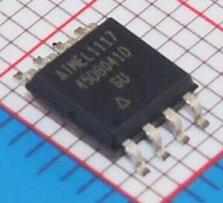产品规格:
产品数量:
包装说明:
关 键 词:存储服务器数据恢复
行 业:电子 电子产品设计
发布时间:2022-11-30
Ready/Busy status is indicated using bit 7 of the status register. If bit 7 is a 1, then the device is
not busy and is ready to accept the next command. If bit 7 is a 0, then the device is in a busy
state. The user can continuously poll bit 7 of the status register by stopping SCK at a low level
once bit 7 has been output. The status of bit 7 will continue to be output on the SO pin, and once
the device is no longer busy, the state of SO will change from 0 to 1. There are eight operations
which can cause the device to be in a busy state: Main Memory Page to Buffer Transfer, Main
Memory Page to Buffer Compare, Buffer to Main Memory Page Program with Built-in Erase,
Buffer to Main Memory Page Program without Built-in Erase, Page Erase, Block Erase, Main
Memory Page Program, and Auto Page Rewrite.
Both the erase and the programming of
the page are internally self-timed and should take place in a maximum time of tEP. During this
time, the status register will indicate that the part is busy.
Buffer to Main Memory Page Program without Built-in Erase
The device density is indicated using bits 5, 4, 3 and 2 of the status register. For the
AT45DB041B, the four bits are 0, 1, 1 and 1. The decimal value of these four binary bits does
not equate to the device density; the four bits represent a combinational code relating to differing
densities of Serial DataFlash devices, allowing a total of sixteen different density configurations.
Main Memory Page Program Through Buffer
This operation is a combination of the Buffer Write and Buffer to Main Memory Page Program
with Built-in Erase operations. Data is first shifted into buffer 1 or buffer 2 from the SI pin and
then programmed into a specified page in the main memory. To initiate the operation, an 8-bit
opcode, 82H for buffer 1 or 85H for buffer 2, must be followed by the four reserved bits and 20
address bits. The 11 most significant address bits (PA10 - PA0) select the page in the main
memory where data is to be written, and the next nine address bits (BFA8 - BFA0) select the first
byte in the buffer to be written. After all address bits are shifted in, the part will take data from the
SI pin and store it in one of the data buffers. If the end of the buffer is reached, the device will
wrap around back to the beginning of the buffer. When there is a low-to-high transition on the CS
pin, the part will first erase the selected page in main memory to all 1s and then program the
data stored in the buffer into the specified page in the main memory. Both the erase and the pro�gramming of the page are internally self-timed and should take place in a maximum of time tEP.
During this time, the status register will indicate that the part is busy.
Additional Commands
Main Memory Page to Buffer Transfer
A page of data can be transferred from the main memory to either buffer 1 or buffer 2. To start
the operation, an 8-bit opcode, 53H for buffer 1 and 55H for buffer 2, must be followed by the
four reserved bits, 11 address bits (PA10 - PA0) which specify the page in main memory that is
to be transferred, and nine don’t care bits. The CS pin must be low while toggling the SCK pin to
load the opcode, the address bits, and the don’t care bits from the SI pin. The transfer of the
page of data from the main memory to the buffer will begin when the CS pin transitions from a
low to a high state. During the transfer of a page of data (tXFR), the status register can be read to
determine whether the transfer has been completed or not.





